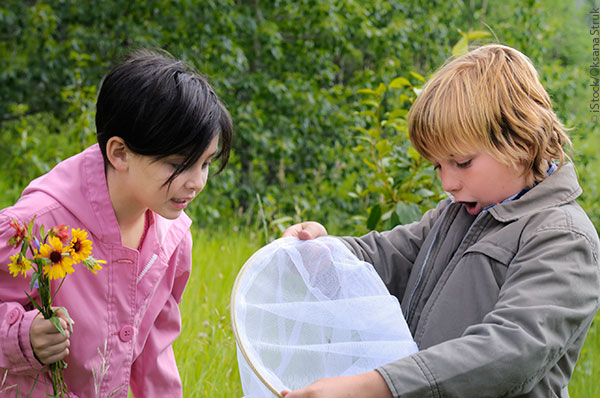Do you have 15 minutes to spare? If so, you can be a citizen scientist. Over the past few years, citizen scientists — ordinary people who help scientists and organizations track the count and behaviors of such creatures and phenomena as birds, butterflies, bees, wildflowers, and even meteors — have been active and helpful information gatherers. After all, researchers can’t be everywhere, and many of us have habitats in our backyards and neighborhoods that can help others gain important information about nature. Some citizen science findings have resulted in important new discoveries that were published in scientific journals, such as this one about the distribution of non-native crickets.
Citizen science also provides a tool for active summer learning, as well as an activity that gets naturalists of all ages outdoors together for a project that helps them better understand local and global ecosystems. Don’t let the name intimidate you. All you need to participate in citizen science is the desire to observe nature to the best of your ability and record what you see.
Here are 11 citizen science projects to try this summer.
- The River Otter Ecology Project
Take part in the first-known study of the status and ecology of Bay Area river otters, which can be observed in streams, rivers and parks. River otters play an extremely important role in sustaining healthy wetlands. There’s good news from early studies, too: Local populations of river otters are expanding.
- The Great Sunflower Project
This popular project, started by San Francisco State biology professor Gretchen LeBuhn, encourages volunteers to observe bees and any other pollinators over time in backyards, parks and trails. According to the Pollinator Partnership, roughly 1,000 plants grown worldwide for food, drinks, fiber, spices and medicine depend on animal pollination, and many pollinators, such as bees, are declining in number. You can also help pollinators by planting a pollinator garden or a monarch way station. - National Moth Week
Held the last full week of July (July 18-26 this year), National Moth Week celebrates the beauty, life cycles, and habitats of moths—one of the most diverse and successful organisms on Earth. You can help observe and track these nocturnal creatures by simply checking a porch or other outdoor light after dark or by attracting moths with a sugary moth food mix. - The Lost Ladybug Project
Help entomologists at Cornell identify spotted ladybugs, many of which have become extremely rare in North America. Participants collect data on the ladybugs they see (or don’t see) and upload their photos. - FrogWatch USA
FrogWatch enlists participants through zoos, aquariums and museums around the U.S. to learn about wetlands and report data on the calls of local frogs and toads, usually during their peak breeding season, from February through August. Frogs and toads play an important role in wetland ecosystems and are considered indicators of environmental health. As with some other species, scientists are interested in learning from their decline. Because this project has more precise protocols than many other citizen science projects, it is probably best for kids 9 and older. You can volunteer for FrogWatch individually, or receive a training at a participating museum like CuriOdyssey in San Mateo. - National Wildlife Federation‘s Wildlife Watch
This is a fun site that lets you print out a Wildlife Watch list by state and then go outside and spot and check off items from the list, from badgers to bellflowers, opossums to ospreys. National Wildlife Federation, U.S. Fish and Wildlife Service and others also provide terrific resources for creating your own habitat garden to encourage and observe wildlife. You don’t need a large space to do this. One very easy way to start is by making and hanging a bird feeder to feed and observe birds.
- Project BudBurst
Participants map multiple plants around the country throughout the year, observing the timing of leafing, flowering and fruiting, which provides scientists with information about climate change.
- Project Squirrel
Urban and suburban scientists can join Project Squirrel, which observes squirrel populations to learn about their habitat, including the effect of people on squirrels.
- The Camel Cricket CensusHere’s a citizen science project you can likely do at home. Camel crickets are common in forests and caves, as well as basements, crawl spaces, sheds and garages across North America. Help scientists at North Carolina State University by photographing and even sending your findings.
- NASA Meteor Count
“Every day, on average, more than 40 tons of meteoroids strike our planet,” according to the National Aeronautics and Space Administration. Much of this comet dust disintegrates high up in Earth’s atmosphere, but some is visible in the form of meteors, or shooting stars. Learn more about the free Meteor Counter app, which uploads observations made from fields and backyards directly to NASA. - Firefly Watch
Traveling to the mid-western or eastern U.S. this summer? Help scientists map fireflies. Because firefly viewing happens at night, most people don’t know that North America is home to more than 150 species of firefly. For humans, there are multiple firefly festivals around the country.
Want to get involved in a citizen science project through a local museum or other organization? Chabot Space and Science Center in Oakland is offering a Coastal Redwood Ecosystem Project. California Academy of Sciences in San Francisco offers multiple citizen science opportunities, as does CuriOdyssey in San Mateo.
Still looking for more fun citizen science projects? Check out SciStarter, UC Davis’ California Naturalist or Cornell’s Citizen Science Central.
Susan Sachs Lipman (Suz) is the author of Fed Up with Frenzy: Slow Parenting in a Fast-Moving World, which contains 300+ activities for family fun and grew out of her blog, Slow Family Online. Slow Parenting and the book were named a 2012 Top 10 Parenting Trend by TIME Magazine. Suz has written for the New York Times’ Motherlode blog, the Christian Science Monitor’s Modern Parenthood blog, and many others. She is the Social Media Manager for JFCS and Parents Place.



